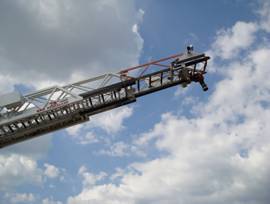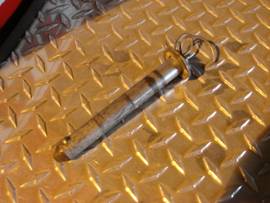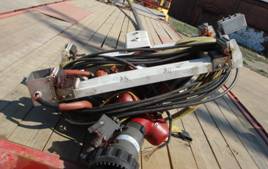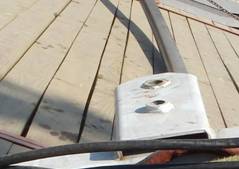| |
May 08, 2008
Improper Set-up of Aerial Ladders with a Locking Waterway May Put Fire Fighters at Risk
NIOSH recommends that all fire departments utilizing aerial ladder trucks with locking (pin-anchored, lever actuated, clamped) waterways immediately take the following actions to reduce the risk of fire fighters being struck by unsecured waterways or parts of the waterway:
-
Ensure that Standard Operating Procedures (SOPs) and/or Guidelines (SOGs) on setting up multi-position waterways include steps to properly position the waterway and to inspect
and
verify that the locking mechanism (anchoring pin(s), lever, clamps, etc.)
are
properly installed and functioning
as designed before pressurizing the waterway.
-
Properly train and practice the correct method of securing waterways and verifying they are secured (per manufacturer’s recommendations).
NIOSH is currently investigating an April 8, 2008
fire fighter line-of-duty-death that illustrates that adhering to manufacturer recommended set-up procedures for aerial ladder operations is paramount to ensuring fire fighter safety.
|
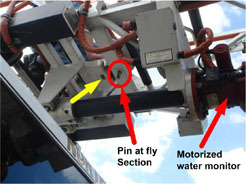
Photo 1 - A properly seated pin at the fly section for defensive water stream operations is highlighted in the red circle. The hole behind it (yellow arrow) shows the location where the pin would be inserted (from the top) to keep the monitor assembly back at the second ladder section for rescue mode. NOTE: Various methods are used throughout the fire apparatus industry to secure the waterway: this picture represents a pin-anchored waterway design.
|
Preliminary findings in this investigation suggest that some equipment designs do not provide secondary stops for the waterway on aerial ladders. Thus, failure to properly secure the waterway in the proper position can lead to catastrophic waterway failure and possible serious or fatal injury to fire fighters working in the area. The pin-anchored waterway design involved in this particular investigation is not limited to a single model or apparatus manufacturer. NIOSH is aware of at least 7 similar incidents that occurred in Delaware, Michigan, New Jersey, Texas, Virginia and Ontario without serious injury. Newer aerial ladder trucks may incorporate different types of anchoring mechanisms and/or a more fail-safe design but proper set up still needs to be verified before operation.
|
|
 |
|
 This
document is also available in PDF format. This
document is also available in PDF format.
sa05082008.pdf
(2 pages, 181kb)

|
|


